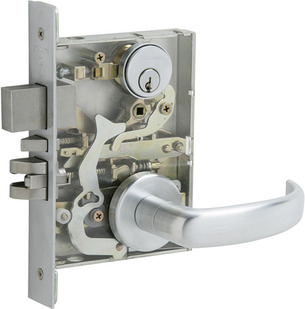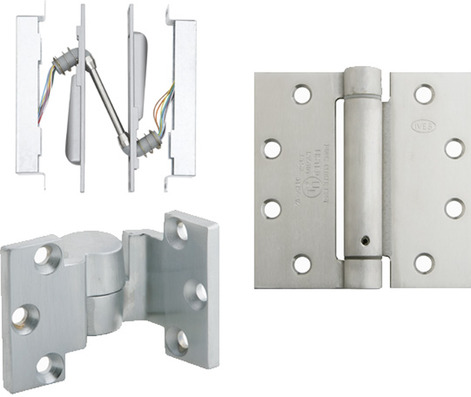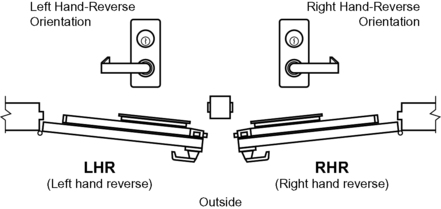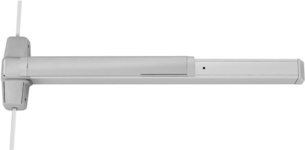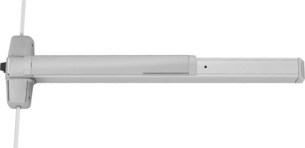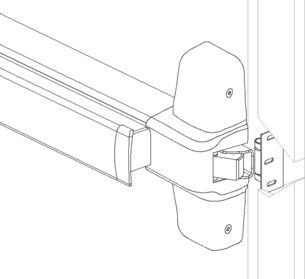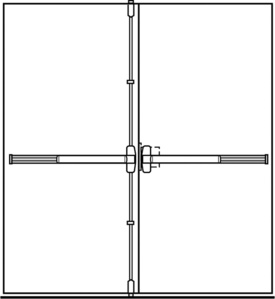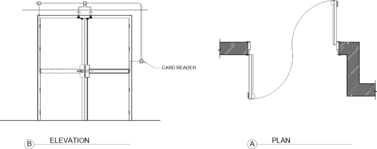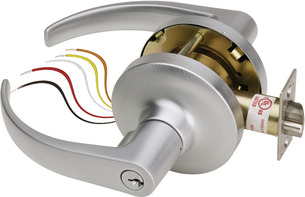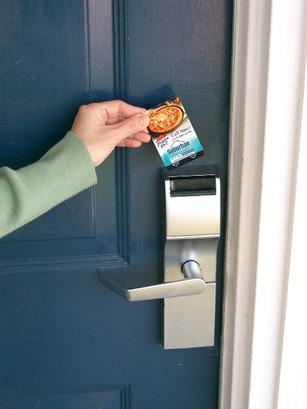10. Free Egress Electrified Locks
Chapter objectives
1. Learn the Basics in the Chapter Overview
2. Learn about Electrified Mortise Locks
3. Understand the Ultimate Free Egress Lock — “Panic” Hardware
4. Learn about Electric Strikes
5. Learn about Electrified Cylinder Locks
6. Answer Questions about Free Egress Locks
CHAPTER OVERVIEW
There is a reason that Free Egress Locks are the first type to learn about — they should be the first type of lock you reach for in any circumstance. The best design rule is to use another kind of lock only if there is a good reason that you cannot use a Free Egress Lock.
Free Egress Locks are called that because they allow any person familiar with the operation of a normal door to walk up to the door and turn the handle or push on the panic bar and go out of the door, no matter what else is happening — no matter if the door is locked from the outside, no matter if it there is a fire emergency or not, no matter what. With this lock a person can always exit the door, and there is “no special knowledge” required to do this.
The person exiting does not have to read a sign and does not have to know something that everyone else does not know (such as how to use a push button to unlock the door), or the ability to read any particular language.
Free Egress Locks are the first and best solution for most electrified locking requirements.
Free Egress Locks should be the first type of lock you reach for in any circumstance. The best design rule is to use another kind of lock only if there is a good reason that you cannot use a Free Egress Lock.
Free Egress Locks have this name because they allow any person familiar with the operation of a normal door to walk up to the door and turn the handle or push on the panic bar and go out of the door, no matter what else is happening, such as if the door is locked from the outside or if it there is a fire emergency. No matter what, a person can always exit the door without any “special knowledge,” such as speaking a particular language.
Keywords: Egress, Emergency, Locks, Panic
Author Information:
Thomas L. Norman, CPP, PSP, CSC, Executive Vice President, Protection Partners International
Types of Free Egress Locks
There are three common types of Free Egress Locks. These include Electrified Mortise Locks, Electrified Panic Hardware, and Electric Strikes. (Okay, technically a strike is not a lock; forgive me for categorizing them together.)
For each of these I will first discuss the lock itself, how it works, variations available, and how it is fitted into doors and frames. Then the types of doors they work best in and what types they should not be used in will be discussed. Finally, their overall benefits and limitations will be reviewed.
Electrified Mortise Locks
An Electrified Mortise Lock is a Mortise Lock to which has been added a solenoid mechanism that can prevent the handle from turning, thus disallowing normal passage through the door to those who are not authorized to enter without a key.
A Mortise Lock is a very strong type of lockset. It is set deeply into a pocket in the door (a mortise). These locks are well known for their strength and security. Mortise locks (and thus Electrified Mortise Locks) are available in many different configurations and can be handed for left- or right-handed doors that swing either in or out.
For most commercial doors in new construction, and many doors in retrofits, Electrified Mortise Locks are the best and safest locks to use. First, let's discuss how Electrified Mortise Locks work. To do that, let's look at a non-electrified mortise lock (a basic mechanical mortise lock; Figure 10.1).
You can see three views in Figure 10.1 (Outside, Inside, and Lock Front) show the working elements of the mortise lock. From the Outside View we can see that the lock with a knob set, mortise cylinder (key-way) and the escutcheon plate that we see as we approach the door. Behind the escutcheon plate you can see the outline of the mortise lock, and extending from that you can see the latch (bottom) and the auxiliary dead-latch, and at the top, you can see the dead-bolt.
On the inside view, you can see the lever handle with its rose (small circular metal disk around the lever set), turn knob, and again the outline of the mortise lock body.
From the Lock Front view, you can see the mortise lock body, knob, lever, key, turn knob, dead-bolt, latch, and dead-latch.
The mortise lock has many useful functions not found in a cylinder lock (discussed later in this chapter). Some common examples are included in the list below.
Mortise Latch Only — No Lock
Passage Set — ANSI F01: This is a non-keyed function. The Passage set is equipped with levers or knobs on both sides and a latch. There is no dead-bolt on the Passage set. Turning the knob or lever retracts the latch from either side.
Mortise Locks with No Dead-Bolt
Office Lock — ANSI F04: This is a keyed lockset. The lock is equipped with knobs/levers on both sides and a key lock on the outside. It is also equipped with stop works buttons below the latch on the strike face. When the stop works is set to unlock, the lock can be opened by turning the knob/lever from either side. When the stop works is set to lock, egress is free by turning the inside knob/lever but the lock can only be operated from the outside by inserting and turning a key, which retracts the latch.
Classroom Lock — ANSI F05: This is a keyed lockset. The lock includes a knob/lever on both sides and is keyed outside. The knob/lever always operates the latch from both sides. The lock is always unlocked unless it is key locked from the outside. In all cases, egress is enabled from the inside by turning the lever/knob.
Classroom Security — ANSI (None): This is a variation on the Classroom lockset that adds a key lock to the inside, enabling the lockset to be locked from both sides with a key. The latchbolt is automatically retracted when operated by the lever/knob from either side unless the lock is enabled by use of a key from either side. In that case the lock is locked from the outside, but it can always be opened by the lever/knob from the inside.
Storeroom Lock — ANSI F07: This is a keyed lockset. The lock includes a knob/lever on the inside and is operated by a key only on the outside. There is no dead-bolt on this lock. The latch operates as a dead-latch; that is, it locks from the outside as it latches. The inside knob/lever is always unlocked and the outside must always be opened by a key.
Institution Lock — ANSI F30: This is a keyed lockset. The lock is equipped with a knob/lever on both sides and is keyed on both sides. The knob/levers are always fixed and do not operate the lock. An auxiliary latch deadlocks the latchbolt when the door is closed and it can be locked by a key from either side.
Mortise Locks with Dead-Bolts
Storeroom Lock with Dead-Bolt — ANSI (None): This is a keyed lockset. The lock is equipped with a knob/lever on both sides, a key on the outside, and a thumb-turn on the inside. It has both a latchbolt and dead-bolt. The latchbolt is retracted by the key outside or by the lever or knob inside. The outside knob/lever is unmovable. The dead-bolt is thrown or retracted by a key outside or thumb-turn inside. Both the dead-bolt and latchbolt can be retracted automatically by turning the inside lever/knob. An auxiliary latch deadlocks the latchbolt when the door is closed. The inside lever/knob is always free for egress.
Corridor Lock — ANSI F13: This is a keyed lockset. The lock includes a knob/lever on the inside and outside and a dead-bolt that can be retracted by a key from the outside or a thumb-turn on the inside. Throwing the dead-bolt locks the outside knob/lever. Turning the inside knob/lever will retract the latchbolt and the dead-bolt and automatically unlocks the outside knob/lever. The inside knob/lever is always free for immediate egress.
Store/Utility Room Lock — ANSI F14: This is a keyed lockset. The lock includes a knob/lever on both sides, is keyed from both sides, and includes a latchbolt and dead-bolt. The latchbolt can be retracted by the knob/lever from either side. The dead-bolt can be thrown or retracted using a key from either side.
Privacy with Dead-Bolt — ANSI F19: This is also a non-keyed function. The Privacy set is equipped with levers or knobs on both sides. It also has a dead-bolt and a turn knob to operate the dead-bolt on the inside and a special emergency coin-turn to operate the dead-bolt from the outside. For the Privacy set, the latch is retracted by the knob or lever from either side. Extending the dead-bolt locks the outside lever. Turning the knob/lever from the inside retracts the latch and dead-bolt and unlocks the outside lever. The Privacy set can be opened in an emergency by inserting a coin into a slot on the outside and using it as a thumb-turn to retract the dead-bolt, which also enables the outside knob or lever.
Entry — ANSI F20: This is a keyed lockset. The Entry set includes knobs or levers inside and outside and also a key lock outside and dead-bolt operated by the key outside or a thumb-turn inside. The lock also has stop works buttons below the latch. The latch is retracted by the knob/lever from either side unless the outside knob/lever has been locked by the stop works buttons or the thumb-turn. The dead-bolt can be extended or retracted by key (outside) or thumb-turn (inside). The outside knob/lever is locked when the dead-bolt is extended. The auxiliary dead-latch deadlocks the latch when the door is closed. The inside knob/lever retracts the latch and dead-bolt simultaneously, allowing for quick free egress under any circumstances.
Dormitory Lock — ANSI F21: This is a keyed lockset. The lock includes a knob/lever on both sides, a key on the outside, and a thumb-turn on the inside. The lock also includes both a dead-bolt and a latchbolt. The latchbolt is retracted by the knob/key from either side. The dead-bolt can be thrown or retracted by a key outside or the thumb-turn inside.
Prison Function Lock — ANSI (None): This is a keyed lockset. The lock includes a knob inside and outside, a key cylinder outside, and no thumb-turn inside. It also includes both a latchbolt and dead-bolt. This type of lock is designed to work with two types of keys (Guard and Prisoner). The outside knob is free-spinning. The dead-bolt is only thrown by the Guard's key. When the dead-bolt is thrown the inside knob becomes fixed. The Prisoner's key only operates the latchbolt and not the dead-bolt. Thus, the prisoner can be provided with a key to his/her cell that allows daytime entry but no exit when the Guard's key locks the dead-bolt.
All of these can be electrified, except for the Passage set, which has no lock function. Electrification involves adding a solenoid inside the lock that prevents the outside lever from turning. When the solenoid is retracted, it ensures that the outside lever can be turned to open the lock, operating additional lock features if necessary to do so.
Electrified Mortise Locks are wired through the back of the lock (opposite the strike face) and require that the door be cored (wood doors) or that a tube be threaded through the door (hollow metal doors) so that wiring can extend from the hinge side of the door to the lock completely through the depth of the door from hinge to strike. Wiring is run from the frame to the door using an electrified hinge, electrified pivot, an Electric Power Transfer (EPT), or a frame/door mounted flexible spring (Figure 10.2).
Door Frame Considerations
Electrified Mortise Locks may require different wiring provisions depending on the type of frame into which the door is set. Doors are commonly fitted into frames so that the door swings 90 degrees to full open. Hinges perform this function and, for electrification of the mortise lock, the installer can use either electric hinges or the EPT unit. However, doors can also be fitted into frames so that they swing to full open at 180 degrees, flat against the wall. In such cases, a special type of hinge is used or the door may open on Pivots (both of which place the hinge point outside the frame to allow the door to swing 180 degrees). In either case, electrified hinges and EPTs will not work. In these instances, one can use either Electrified Pivots (the top pivot is wired) or the pocketed coil (through which wiring is threaded). The pocketed coil will wrap around the frame to accommodate the fully open door.
Additional Lock Switch Fittings
Electrified Mortise Locks can also be fitted with additional features including:
• Door Position Switch
• Latch Position Switch
• Dead-Bolt Position Switch
• Interior Lever Handle Release Switch
The door position switch includes a magnetic switch that is installed in the lock and matches up with a magnet in the strike plate. This functions to tell the system that the door is closed. These are unusual and rare. The Latch Position Switch signals that the latch is engaged into the strike pocket. This functions to tell the security system that the lock is latched.
The Dead-Bolt Position switch signals that the dead-bolt is extended. This functions to tell the security system that the door is deadlocked. The Interior Lever Handle Release Switch signals when the interior handle has been turned, releasing the latch to open the door. It functions as a Request-to-Exit sensor. Whenever possible, use an Electrified Mortise Lock that is properly equipped with appropriate internal switches, especially the internal Request-to-Exit sensor.
Door Handing
A note about door handing is in order. Doors open inward or outward and the lock may be on the right or the left. When you order a lock, it is important to order it correctly so that it will work in the correct door configuration (Figure 10.3).
Electrified “Panic” Hardware
The second major category of Free Egress locking devices is Electrified Panic Hardware. This is also one of the most familiar locks in the world, seen everywhere on public buildings, but mostly on exit doors.
Again, before we talk about Electrified Panic Hardware, let's look first at mechanical Panic Hardware. The purpose of Panic Hardware is to get a lot of people out of a building quickly in an emergency. Were it not for the need to quickly exit large numbers of people in emergencies, there might be little need for Panic Hardware.
Panic Hardware are known as Exit Devices in code documents. So we will call them that from now on in this chapter.
Rim Exit Devices
Rim Exit Devices comprise one or a pair of Panic Bars with a latch built into the Panic Bar. In the case of a pair of doors, Rim Devices require a center mullion so that the Panic Bar Latch in each leaf can have a strike edge to close against. Rim Exit Devices are not common on double doors because it is undesirable to have the mullion separating the two halves of the double entryway.
The Electrified Rim Device (Figure 10.4) is operated by a solenoid within the Panic Bar that retracts the latch in response to an electric signal. When the latch is retracted by the solenoid, the door can be opened from the outside, and exit is always possible by pushing on the Panic Bar. A pneumatically controlled version is also available. Additionally, a variety of “Electrical Options” are available. See the section Electrical Options for the complete list.
Mortise Lock Exit Devices
The Mortise Lock Exit Device (Figure 10.5) comprises a Panic Bar connected to a modified conventional mortise lock. There is a horizontal cutout in the mortise lock into which a lever from the Panic Bar extends, engaging a lever in the mortise lock.
When electrified, the same solenoid that operates in the Rim Exit Device is used to operate the Panic Bar lever that extends into the mortise lock. When the solenoid is activated, the latchbolt on the mortise lock retracts, allowing the door to be opened from the outside, but one can always exit freely by pushing on the Panic Bar. As in the Rim Device, a pneumatically controlled version is also available (see the section Electrical Options).
Surface-Mounted Vertical Rod Exit Devices
Surface-mounted Vertical Rod Exit Devices (Figure 10.6) are most often used on double doors where it is undesirable to have a center mullion that would otherwise divide the double entry-way into two. To latch the doors a pair of vertical rods extends from the center case of the Panic Bar where they terminate into latches at the top and bottom of the door. The latches latch into a top strike at the top of the door, which is surface mounted, and into a bottom strike at the bottom of the door, which is fitted into the threshold.
When electrified, the same solenoid discussed earlier is used to operate a cam in the center case of the Panic Bar, which causes the vertical rods to retract from their home (extended) position. When extended, they are engaged with the top and bottom strike plates. The vertical rods can be retracted by pushing on the Panic Bar on the inside of the door, depressing a lever or latch on the outside or by activating the solenoid in the Panic Bar when it is activated by an Access Control Panel's Lock Relay.
One can always exit freely by pushing on the Panic Bar. As in the Rim Device, a pneumatically controlled version is also available (see the section Electrical Options).
Concealed Vertical Rod Exit Devices
Concealed Vertical Rod Exit Devices (Figure 10.7) operate on exactly the same principle as the Surface-mounted Vertical Rod Exit Devices; however, on these units, the working mechanism and top/bottom latches are built into the door. This approach provides a much more visually aesthetic presentation than with Surface-mounted Vertical Rod Exit Devices. These are typically built into hollow metal doors; however, a special version of these is also made for solid core wood doors.
In all other respects, Concealed Vertical Rod Exit Devices operate exactly the same as their Surface-mounted cousins.
Three-Point Latching Exit Device
The Three-Point Latching Exit Device (Figure 10.8) is a more secure version of the Surface-mounted Vertical Rod Exit Device. In the Three-Point Latching Exit Device a Rim Latch is added to Surface-mounted Vertical Rods to create three points of latching instead of only one (Rim) or two (Surface Mounted Vertical Rods). The Three-Point Latching Exit Device must be used either as a single door or with a center mullion between a pair of doors.
In the electrified version, the same familiar Panic Bar solenoid operates all three latches.
Exit Device Functions
Normal Function: In the normal function of the Exit Device egress is always free by pushing on the Panic Bar and entrance is controlled by the latch. After the door opens, it will latch again when it closes.
Latch Dogging: The term “dogging” refers to holding the latch(es) of a panic device retracted to create a push/pull function. 1 When the latch is dogged, the latch remains retracted so that the door can close, but not latch. Dogging of latches is not legal on fire egress doors because the doors are required by code to latch when they close; however, it is legal to dog the dead-bolt on specialized locks, if one exists. Fire exit hardware can be dogged electrically when interfaced with the fire alarm system.
Electrical Options
Request-to-Exit (RX): The Request-to-Exit switch is an internal switch operated by the Panic Bar. This signals the Access Control Panel that the door is being opened for a legal exit and is not from the outside as an intrusion.
Latchbolt Monitoring (LX): The latchbolt monitoring kit is a switch located inside the Panic Bar and is interfaced to the latchbolt, alerting whenever the latchbolt is retracted. The latchbolt monitor kit is a signaling device and cannot operate a load.
Electric Latch Retraction (EL): Electric Latch Retraction is the basis for remotely unlocking an Electrified Panic Hardware equipped door. An electrical signal operates a solenoid within the Panic Bar, which retracts the latchbolt, allowing the door to be opened from the outside. Electric Latch Retraction can also be used to coordinate the Electrified Panic Hardware with Automatic Door Openers to ensure that the door is unlatched before the automatic opener attempts to open the door. In such cases a short delay (250 ms) should be inserted between the command to unlatch the Panic Bar and energize the Automatic Door Opener.
Signal Switch (SS): A Signal Switch combines the RX switch with the LX, combining both functions into a single signal. Because both are monitored, the door is tamper monitored, making it more secure. The Signal Switch is functionally used as a Request-to-Exit sensor, signaling the Access Control Panel to allow passage.
Electric Mortise Lock Device (E7500): Combining Panic Hardware with an Electrified Mortise Lock, the Electrified Mortise Lock Device allows the mortise lock to be electrically controlled to remotely unlock the door. When unlocked, the door remains latched, preserving the fire rating. This combination is very useful where codes permit locking, but require unlocking during an emergency (such as for approved fire stairwells). The Electric Mortise Lock Device is typically also combined with the RX switch to signal an authorized exit.
Electric Rim Device (E99): The Electric Rim operates the mechanical Rim type Panic Hardware by use of a solenoid within the Panic Bar. This function also combines a switch to monitor the outside trim condition (locked or unlocked) and a second switch to monitor the latchbolt.
Alarm Kit (ALK): The Alarm Kit is a battery-operated alarm designed to deter unauthorized use of the door. Although a person can exit using the Panic Bar, an alarm will sound at the door unless it has been bypassed by a key switch on the Panic Bar. The alarm horn provides an audible alert that the door is being opened. This deters the use of the door, although it is still available for emergencies.
Pneumatic Controlled Devices (PN): The pneumatic option operates the same as the solenoid function, but is safe for hazardous areas and areas where a spark could cause an explosion (intrinsically safe operation).
Popular Double Door Applications
Several popular double door applications are shown in the illustrations below. These include:
-Figure 10.9 Rim Devices - Same Direction.
-Figure 10.10 Mortise Lock and Vertical Rods - Same Direction.
-Figure 10.11 Two Vertical Rods - Same Direction.
-Figure 10.12 Double Egress using Vertical Rods.
-Figure 10.13 Upper-only Vertical Rods.
These illustrate how the various lock types are applied to common exiting applications.
Electric Strikes
Electric Strikes are access control devices that can be used with conventional mechanical locks to allow the door to be opened regardless of the lock/unlock status of the mechanical lock. The Electric Strike replaces the fixed strike faceplate normally found on door frames, into which the mechanical lock latchbolt extends when it closes, thus latching the door.
Just like a fixed strike faceplate, the Electric Strike normally presents a ramped surface for the mechanical latch to close against. As the door closes, the latchbolt retracts momentarily to accommodate the ramped surface, and then springs back to extend again into the latch pocket when the door is fully closed. The latch is kept in place by the back of the ramped surface, called a latch keeper.
However, unlike a conventional fixed strike faceplate, the electric strike has a solenoid that controls the position of the latch keeper. In its quiescent state, the latch keeper is fixed, like the keeper of a fixed strike faceplate. But when the solenoid is activated, the latch keeper can swing aside, allowing a space where the extended latch is free to open with the door. Thus the door can be opened while the lock is still locked.
Electric Strikes are available in either fail-safe or fail-secure functions. Fail-safe, also called fail-open, causes the electric strike to lock when power is applied. Fail-safe unlocks the electric strike when power is applied.
Electric Strikes are available in either AC or DC versions. AC versions “buzz” when operated, while DC versions are nearly silent, except for a quiet “click” when the lock is released. DC electric strikes are sometimes equipped with a buzzer to signal a person outside that the strike is open.
Switches Available for Electric Strikes
Latch-Bolt Monitoring Switch: Electric Strikes can often be ordered with a latchbolt position sensor, which many use like a door position switch to determine if the door is open or closed. Please note that the latchbolt position sensor is not equivalent to the door position switch. It is possible to place a wad of paper in the latch pocket holding the latchbolt position sensor closed, thus fooling the Access Control System into thinking that the door is closed when it is actually open.
Dead-Bolt Monitoring Switch: Electric Strikes built to accommodate mechanical locks with dead-bolts may also be equipped with a dead-bolt position monitoring switch.
Lock Status Monitoring Switch: This switch identifies the condition of the electric strike's locking mechanism, telling the Access Control System if the strike is locked or unlocked.
You should exercise caution when modifying an existing door frame to accept an electric strike to be certain that you are not doing so on a fire-rated door frame. Such a modification would void the fire rating of the frame.
Electrified Cylinder Locks
Electrified Cylinder Locks (Figure 10.14) are mechanically similar to a standard mechanical cylinder lock, but with the addition of a small internal solenoid that remotely releases the lock. Electrified Cylinder Locks are inexpensive and are common on light-duty doors under direct supervision. Like all cylinder locks, electrified cylinder locks lack physical strength, and it is inadvisable to use one as a security device.
Electrified Cylinder Locks are generally available in either 12 or 24 volt versions and also as AC or DC activated. AC versions create a buzzing sound that alerts users outside that the lock is unlocked.
Self-Contained Access Control Locks
The final category of Free Egress locks is a specialty category commonly found on Hotel Room Doors. Increasingly, however, these are also on stand-alone specialty doors where connection to an Electronic Access Control System is not practical for economic reasons.
The lock comprises an Electrified Cylinder Lock controlled by a card reader, keypad, or fingerprint reader that is part of the lock itself. These are usually battery operated. When a valid card, keycode, or enrolled fingerprint is presented, a small processor within the lock is activated and processes the request. If the credential presented is valid in the small lock database, a solenoid is activated, releasing the lock. An indicator light on the lock indicates that the lock can be opened. These locks typically have a data connection port allowing upload and/or download of stored credentials and transaction records (Figure 10.15).
Chapter Summary
1. There are three common types of Free Egress Locks: Electrified Mortise Locks, Electrified Panic Hardware, and Electric Strikes.
2. A Mortise Lock is a very strong type of lockset.
3. An Electrified Mortise Lock is a Mortise Lock to which has been added a solenoid mechanism that can prevent the handle from turning, thus disallowing normal passage through the door to those who are not authorized to enter without a key.
4. Electrified Mortise Locks may require different wiring provisions depending on the type of frame into which the door is set.
5. Electrified Mortise Locks can also be fitted with additional features including:
• Door Position Switch
• Latch Position Switch
• Dead-Bolt Position Switch
• Interior Lever Handle Release Switch
6. Door Handing: When you order a lock, it is important to order it correctly so that it will work in the correct door configuration.
7. The second major category of Free Egress locking devices is Electrified Panic Hardware.
8. The third category of Free Egress locking devices is Electrified Strikes.
9. Electric Strikes are access control devices that can be used with conventional mechanical locks to allow the door to be opened regardless of the lock/unlock status of the mechanical lock.
10. Electrified Cylinder Locks are mechanically similar to a standard mechanical cylinder lock, but with the addition of a small internal solenoid that is used to remotely release the lock.
11. The final category of Free Egress locks is a specialty category, commonly found on Hotel Room Doors.
1) Three common types of Free Egress Locks include:
a. Electrified Mortise Locks, Magnetic Locks, and Electrified Dead-Bolt Locks
b. Electrified Mortise Locks, Magnetic Locks, and Electrified Panic Hardware
c. Electrified Mortise Locks, Magnetic Locks, and Electric Strikes
d. Electrified Mortise Locks, Electrified Panic Hardware, and Electric Strikes
2) An Electrified Mortise Lock
a. Is a Mortise Lock to which has been added a solenoid mechanism that can prevent the handle from turning, thus disallowing normal passage through the door to those who are not authorized to enter without a key
b. Is a very strong type of lockset
c. Is the best and safest lock to use for most commercial doors in new construction
d. All of the above
3) Electrified Mortise Locks
a. May require different wiring provisions depending on the type of frame into which the door is set
b. Are commonly fitted into frames such that the door swings 90 degrees to full open
c. Can use electrified hinges or Electric Power Transfer (EPT) units to provide power to the lock
d. All of the above
4) Electrified Panic Hardware
a. Causes people to panic
b. Keeps people from panicking
c. Allows large quantities of people to exit quickly in an emergency
d. None of the above
5) Electric Strikes
a. Are access control devices that can be used with conventional mechanical locks to allow the door to be opened regardless of the lock/unlock status of the mechanical lock
b. Are access control devices that can be used with conventional mechanical locks to allow the door to be opened only when the electric strike is mechanically bonded to the top of the door
c. Both b and c
d. Neither a nor b
6) Electrified Cylinder Locks
a. Are mechanically similar to a standard Mortise Lock, but with the addition of a small internal solenoid that is used to remotely release the lock
b. Are mechanically similar to a standard panic hardware, but with the addition of a small internal solenoid that is used to remotely release the lock
c. Both a and b
d. Neither a nor b
7) Self-Contained Access Control Locks
a. Are used in large quantities in commercial buildings
b. Are most common in frameless glass doors
c. Both a and b
d. Neither of the above
Answers: 1) d, 2) d, 3) d, 4) c, 5) a, 6) d, 7) d
..................Content has been hidden....................
You can't read the all page of ebook, please click here login for view all page.

